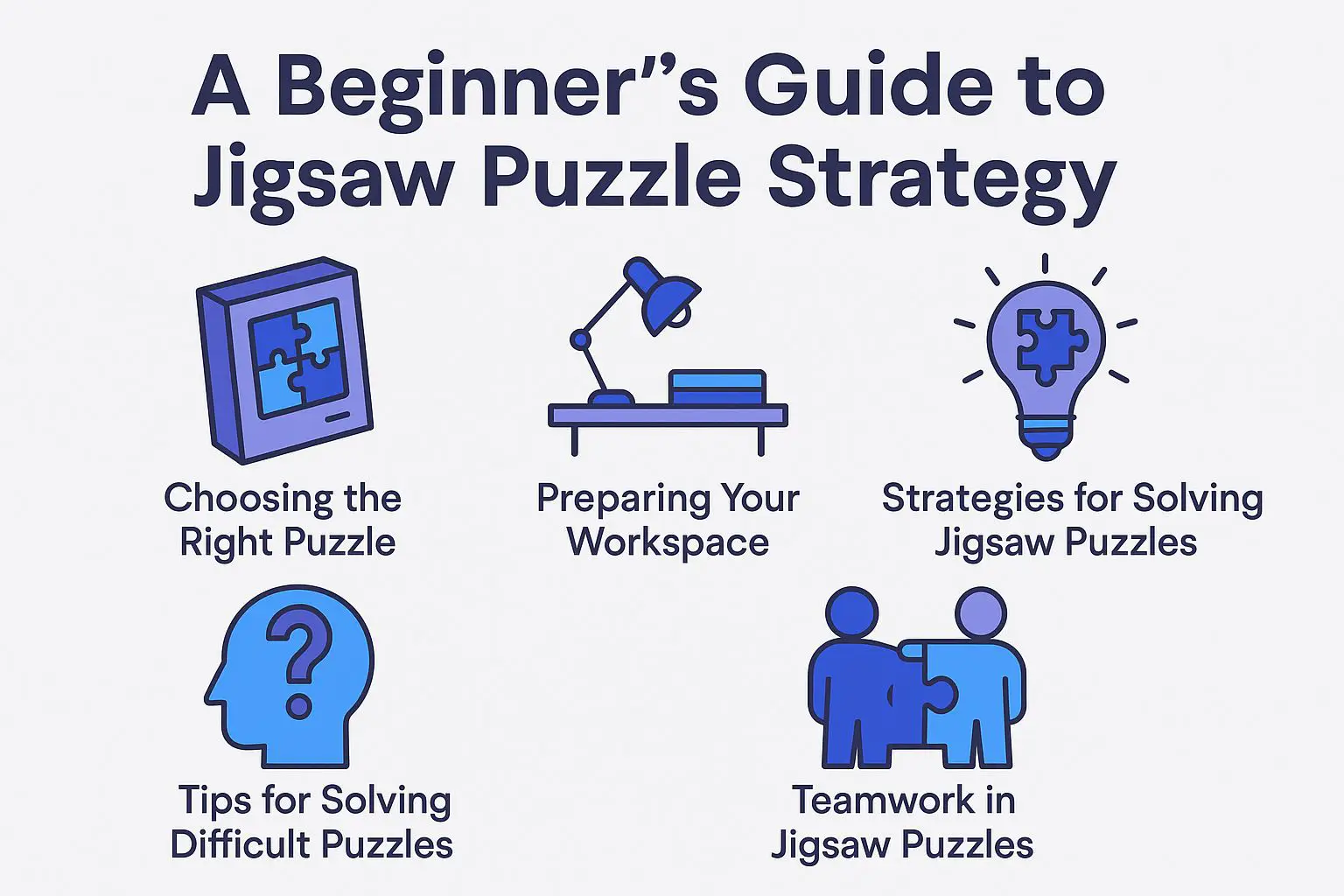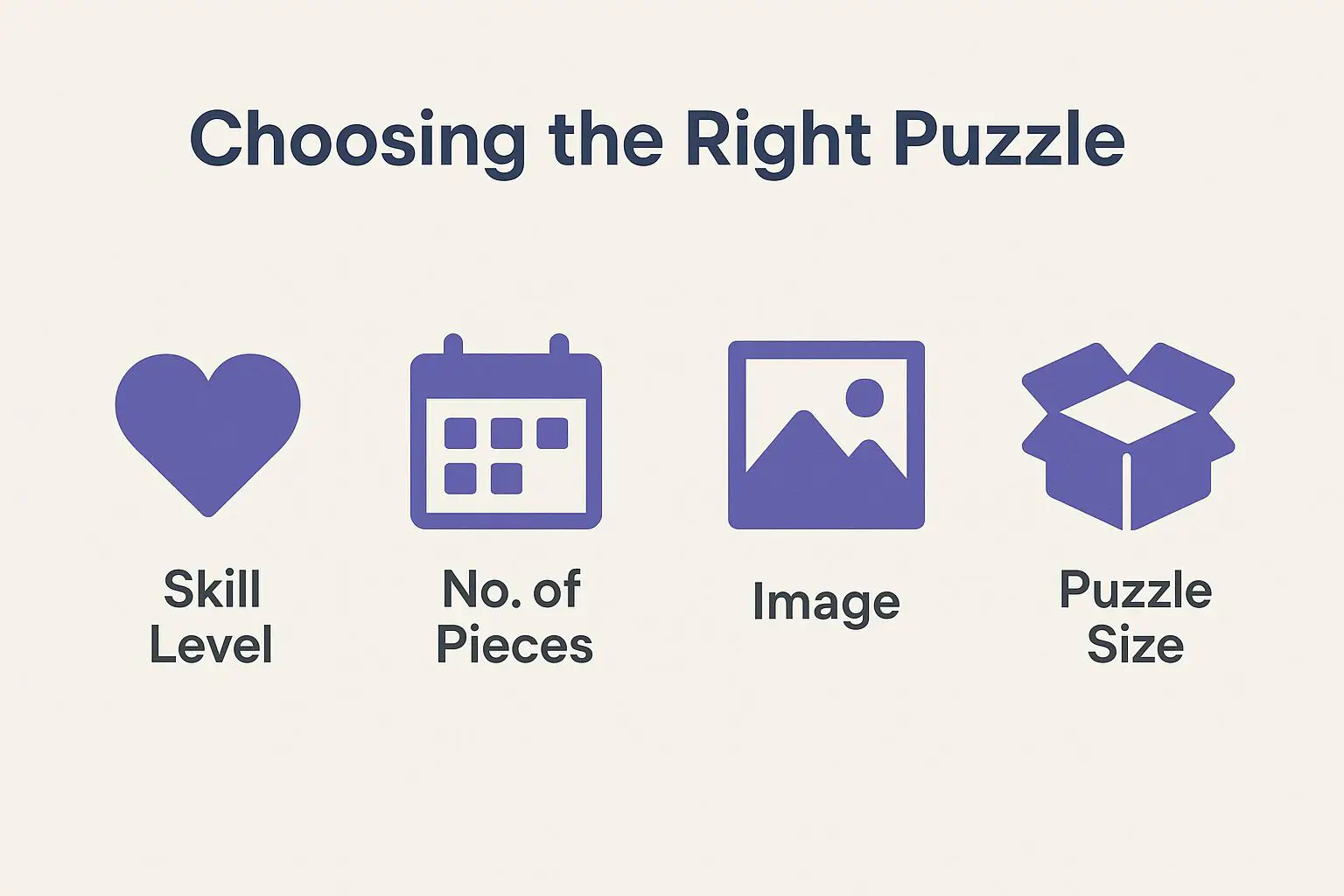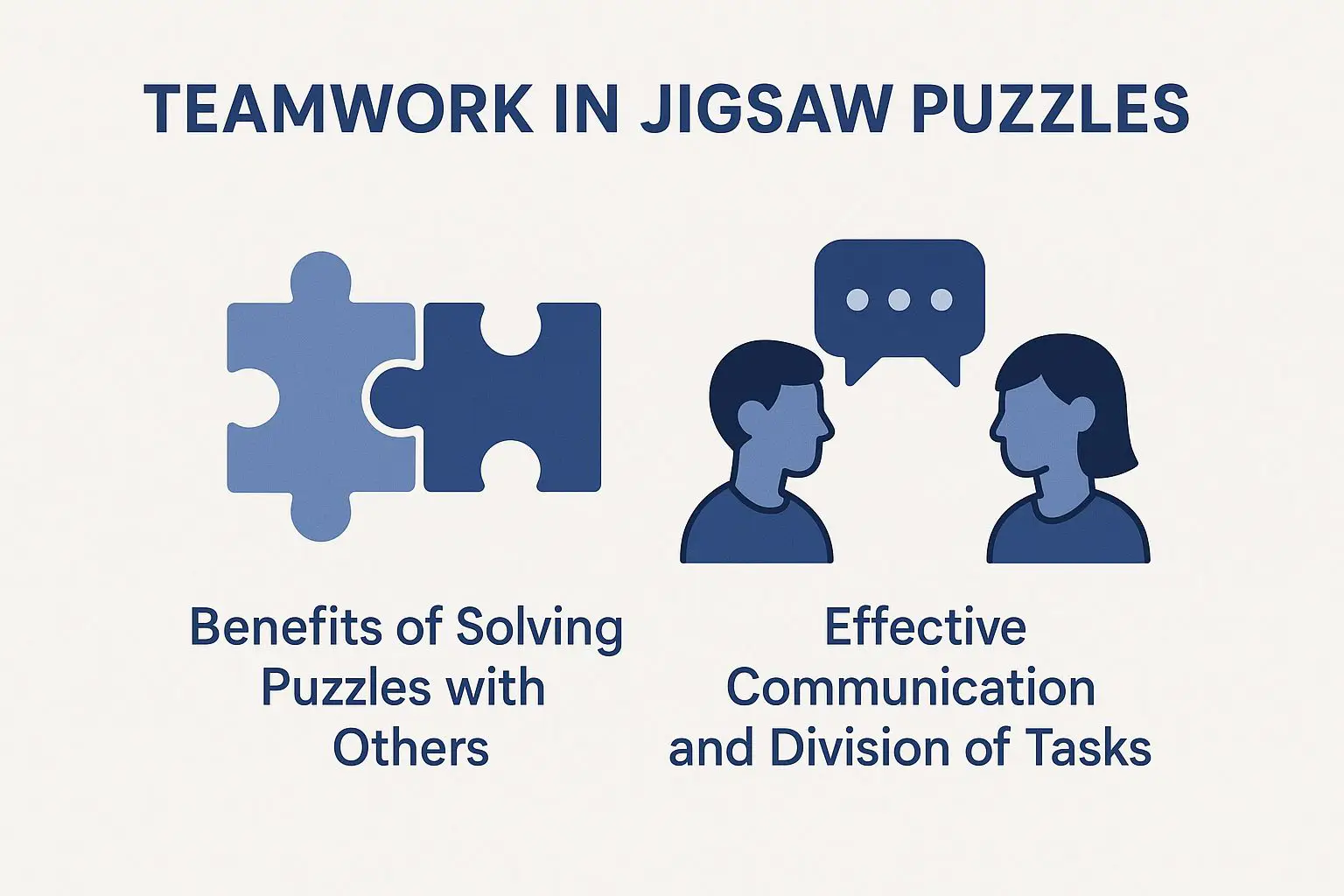
A Beginner's Guide to Jigsaw Puzzle Strategy
Jigsaw puzzles are more than just a pastime; they provide a combination of challenge and relaxation. Whether someone is an experienced puzzler or just beginning, grasping the techniques for solving these intricate images can improve their overall experience. This guide examines the various benefits of jigsaw puzzles, offers tips for choosing the right one, and presents strategies for effective solving. It also highlights how teamwork can enhance the puzzling experience. This exploration aims to help individuals unlock their puzzling potential and enjoy many hours of engagement.
🔑 Key Takeaways
- Choose the right puzzle by considering factors such as difficulty level, number of pieces, and theme.
- Be strategic in solving jigsaw puzzles by working on edge pieces first, grouping by color or pattern, and breaking the puzzle into smaller sections, employing expert tips to become a puzzle master.
- For difficult puzzles, practice persistence and patience, use reference images, and take breaks to prevent frustration. Teamwork can also be beneficial for solving puzzles.
What is a Jigsaw Puzzle?
A jigsaw puzzle is a challenging and engaging recreational activity where players assemble a picture from numerous interlocking pieces, often made from cardboard, that vary in shape and size, which can range from easy 300-piece puzzles to complex 1000-piece puzzles and beyond. This traditional pastime has evolved into a vibrant community of puzzle enthusiasts who share custom puzzles, techniques, and strategies to enhance the experience, making it enjoyable for all ages, particularly beginner puzzlers looking to develop their puzzle skills.
Historically, jigsaw puzzles originated in the 18th century, initially crafted from wood and used as educational tools. For a detailed look at its origins, Britannica offers an insightful exploration of the history and facts about jigsaw puzzles.
Today, there are various types of puzzles available, including custom puzzles:
- Artistic designs known as puzzle art
- Unique gradient puzzles that challenge the solver's color recognition
- 3D puzzles that offer a dimensional twist
With the rise of online puzzle stores, enthusiasts can access a myriad of options from around the globe, expanding the appeal of this pastime.
Whether searching for intricate scenes or memorable images, the diversity in materials and designs ensures that there's something for everyone, further enriching the puzzle community and enhancing the puzzle-solving experience.
Benefits of Solving Jigsaw Puzzles
Solving jigsaw puzzles offers a myriad of benefits that extend beyond mere entertainment; it serves as an engaging brain workout that enhances cognitive skills, improves memory, and fosters patience techniques while providing a relaxing activity that can be enjoyed alone or as a rewarding family activity.
The process of assembling a puzzle not only promotes mindfulness but also creates opportunities for social puzzling and bonding among friends and family, making it a fulfilling pastime for puzzle enthusiasts of all ages.
Along with sharpening problem-solving abilities, this engaging pursuit cultivates emotional resilience as individuals navigate challenges inherent to piecing together complex images.
Puzzles can transform into meaningful family traditions, where loved ones gather to collaborate, fostering connections and mutual support.
Local communities often organize puzzle-solving events, further strengthening social ties and promoting collective engagement.
The joy of completing a jigsaw not only brings a sense of accomplishment but also encourages relaxation, allowing participants to unwind and escape the pressures of daily life.
Ultimately, puzzles serve as a delightful way to nurture the mind, heart, and spirit.
Choosing the Right Puzzle
Choosing the right jigsaw puzzle is essential for an enjoyable experience, particularly for beginner puzzlers, as it can significantly impact their engagement and satisfaction; considerations include the puzzle's piece count, image complexity, and whether it involves sorting pieces by color or pattern, as well as the availability of tools like puzzle mats and boards to optimize the workspace.
Moreover, engaging in puzzles can lead to exciting puzzle competitions where participants can challenge their skills and experience the thrill of social puzzling.

Factors to Consider
When choosing a jigsaw puzzle, several factors must be considered to ensure a fulfilling experience, particularly for beginner puzzlers; these include the piece shapes, the complexity of the image, and the level of detail, as well as effective color sorting strategies and overall puzzle organization techniques. Understanding these elements can enhance your puzzle-solving skills and provide expert tips on how to approach larger puzzles with patience and enjoyment.
It's essential for those new to the world of puzzles to think about the type of image that resonates with them, as this can significantly impact their motivation and engagement.
For instance, vibrant landscapes, intricate portraits, or whimsical illustrations can all offer different levels of challenge and enjoyment.
The configuration of pieces plays a critical role; puzzles with larger, uniquely shaped pieces are often more approachable for beginners, while more advanced individuals might relish the challenge of complex designs with numerous tiny pieces.
Developing effective organization methods, such as sorting pieces by color or edge, can streamline the process and foster a more satisfying puzzle experience with the use of puzzle mats.
Preparing Your Workspace
Creating an effective puzzle workspace is crucial for an enjoyable jigsaw puzzle experience, as it allows for optimal focus and organization; consider utilizing puzzle mats and boards for easy assembly, ensuring ample natural light to enhance visibility, and implementing an organizing system for sorting pieces, turning into a puzzle corner.
This setup not only aids in the efficient assembly of the puzzle but also keeps the workspace tidy and inviting, contributing to overall puzzle enjoyment.

Gathering Materials and Setting Up
To effectively gather materials and set up for your jigsaw puzzle, consider essential tools such as puzzle mats and boards to provide a stable working surface while accommodating various piece shapes and sizes.
This preparation not only enhances the assembling process but also showcases your puzzle art, turning it into a visual delight as you progress through the pieces.
Choosing a puzzle mat that features a non-slip surface can significantly prevent pieces from sliding around, ensuring an organized workspace.
Flat puzzle boards offer the added benefit of portability, allowing enthusiasts to easily transport their work without disrupting progress.
It's also advisable to have sorting trays or containers handy; these can help keep pieces organized by color or pattern, streamlining the assembly process.
By investing time in creating an efficient and tidy setup, the experience of piecing together the puzzle becomes even more enjoyable, making each session a rewarding endeavor.
Strategies for Solving Jigsaw Puzzles
Employing proven strategies for solving jigsaw puzzles can significantly enhance your efficiency and enjoyment, with puzzle techniques such as starting with edge pieces to establish a clear border, flipping pieces to identify colors and patterns, and breaking the puzzle into smaller sections for easier assembly being key methods.
By utilizing these puzzle techniques, puzzlers can transform the sometimes daunting task of assembling a puzzle into a structured and satisfying experience. As noted by insights from LinkedIn, solving puzzles can also teach valuable lessons applicable to work and life, reinforcing the importance of strategic thinking and patience.

Edge Pieces First: Puzzle Framing Techniques
Starting with edge pieces first is a widely recognized strategy among puzzle enthusiasts, as it helps establish a defined border for the puzzle that serves as a framework, making it easier to visualize the overall picture as you work within your puzzle workspace. This technique not only enhances organization but also allows for a clear focus on assembling the border before tackling the internal sections.
Identifying edge pieces can be streamlined by sorting them into categories based on their shapes and colors, allowing for a more efficient assembly process.
Look for straight edges, which are typically found on borders, and consider using a separate area of your puzzle workspace for these pieces. Grouping them by color or pattern can significantly speed up the assembly of the border, employing effective puzzle organization strategies.
This strategic approach not only provides a sense of accomplishment as the frame takes shape but also sets a solid foundation for the next phases of the puzzle, ensuring that a clear pathway is established for completing the intricate inner sections.
Grouping by Color or Pattern
Grouping jigsaw puzzle pieces by color or pattern is a highly effective sorting strategy that aids in the organization of your workspace, allowing for quick access to similar pieces and enhancing the efficiency of the assembling process. Employing color variation and an effective organizing system enables puzzlers to methodically tackle small sections of the puzzle, significantly reducing frustration and improving overall enjoyment.
This technique not only streamlines the visual search for pieces but also permits puzzlers to easily identify which sections are missing or completed.
By categorizing pieces into distinct color groups, one can focus on assembling specific areas of the puzzle that share identical hues, fostering a more logical approach to problem-solving.
Utilizing various sorting methods can help in managing larger puzzles, minimizing the time spent rummaging through disorganized heaps.
As a result, the engaging activity transforms into a more enjoyable and structured experience, ultimately leading to a satisfying completion.
Working on Small Sections
Focusing on small sections of a jigsaw puzzle is a practical approach that can greatly enhance your solving experience, allowing you to build confidence and progressively complete different areas while employing effective puzzle techniques and puzzle strategy. This method, combined with patience techniques, keeps you engaged and helps maintain a positive attitude throughout the assembly process, making the activity more enjoyable and providing valuable beginners guide.
By breaking the puzzle down into manageable pieces, solvers can tackle each section methodically, which not only simplifies the process but also provides a sense of accomplishment as they see individual sections coming together, turning an easy puzzle into an enjoyable challenge.
This strategy promotes the use of logical thinking and categorization, as one might group pieces by color, edge type, or pattern, making it easier to assemble puzzle sections. Focusing on smaller areas reduces the overwhelming feeling that can accompany larger puzzles, allowing enthusiasts to genuinely savor the journey of creation.
Ultimately, embracing this approach can lead to a more satisfying and fulfilling puzzle-solving experience, especially when visualizing puzzle solutions.
Tips for Solving Difficult Puzzles
Solving difficult jigsaw puzzles can be a rewarding yet challenging endeavor; implementing expert tips such as practicing persistence and patience, taking breaks, and approaching puzzle challenges with a positive mindset can transform the experience into a fulfilling mental workout that engages the brain.
These strategies not only help in overcoming obstacles but also enhance overall puzzle enjoyment as you work through intricate designs, such as unique puzzles or nature puzzles.
Persistence and Patience
Cultivating persistence and patience is essential for successfully solving challenging jigsaw puzzles, as these qualities enable puzzlers to navigate through frustrations and maintain focus on the ultimate goal of completing the image. By applying persistence techniques and patience techniques, individuals can enjoy a rewarding mental workout that not only sharpens their puzzle skills but also enhances problem-solving abilities, making it a fun family activity.
For instance, setting aside dedicated time for puzzle-solving can foster a deeper commitment, allowing one to gradually piece together complex sections without feeling rushed, such as while assembling border pieces on a 500-piece puzzle.
Breaking the puzzle into smaller, manageable parts can lessen the overwhelming feeling that often accompanies larger images.
Techniques such as visualizing the finished scene, celebrating small victories like connecting pieces, or even taking short breaks can improve concentration and reinforce the importance of a steady approach, particularly when using puzzle trays or stackable sorters.
Embracing the journey rather than just focusing on the outcome encourages an enjoyable and fruitful experience, ultimately leading to greater success in puzzle-solving.
Using Reference Images
Utilizing reference images is a valuable strategy when tackling jigsaw puzzles, as they serve as visual guides that help you visualize the overall design and assist in placing pieces accurately, which is especially useful for puzzle sorting. This technique not only aids in enhancing your puzzle techniques but also engages the brain, providing expert tips on how to effectively navigate through difficult sections.
Reference images offer significant benefits by allowing puzzlers to break down the image into manageable sections, making it easier to identify colors, patterns, and shapes, thus speeding up the solving process.
By comparing the pieces in front of them with the reference image, individuals can quickly determine where certain pieces belong, streamlining the solving process. This approach can particularly help in challenging puzzles with similar colors or intricate details, ultimately leading to a greater sense of accomplishment.
Using reference images fosters critical thinking and problem-solving skills, which are transferable to various aspects of life outside of the puzzle realm.
Taking Breaks
In the pursuit of solving jigsaw puzzles, taking breaks is a critical component that can rejuvenate focus and maintain enthusiasm throughout the challenge. Allowing yourself moments of rest not only enhances persistence techniques but also contributes to a more enjoyable experience, ensuring your brain remains engaged and refreshed for the next session.
By stepping away for a short time, puzzlers can recharge mentally, reducing fatigue and frustration that often accompanies long, intense periods of focus, similar to a mental workout.
This strategy not only helps in sustaining motivation but also fosters creative problem-solving skills, as fresh ideas can form during these intermissions.
It's fascinating how the simple act of pausing can lead to breakthroughs in completing that stubborn section of the puzzle!
Embracing regular breaks can truly enrich the overall enjoyment, transforming a challenging task into a more gratifying and fulfilling pastime.
Teamwork in Jigsaw Puzzles
Engaging in social puzzling through teamwork in jigsaw puzzles can significantly enhance the overall experience; solving puzzles with others brings about numerous benefits, such as shared enjoyment, increased conversation, and the ability to tackle challenging puzzles more efficiently.
Effective communication and division of tasks among team members can streamline the assembly process and create a fun and collaborative atmosphere, making it a cherished activity for family and friends alike, and enhancing the puzzle community spirit.

Benefits of Solving Puzzles with Others
Solving jigsaw puzzles with others offers numerous benefits that extend beyond mere collaboration; it enhances puzzle enjoyment and fosters social connections, creating a memorable family activity that engages the brain and encourages teamwork, especially around the dining room table.
The shared experience of tackling puzzle challenges together not only strengthens relationships but also turns the puzzle-solving process into a fun and interactive endeavor.
As families come together to piece together a vibrant scene, they share laughter, stories, and strategies, deepening their bonds in the process.
The act of collaboratively working towards a common goal cultivates an atmosphere of cooperation and patience, while also instilling a sense of achievement upon completion.
These moments can be an excellent opportunity for teaching valuable life skills such as communication and problem-solving.
In essence, gathering around a table filled with puzzle pieces transforms an ordinary day into a delightful adventure, reinforcing emotional connections and creating lasting memories that families will cherish for years to come, potentially with the help of puzzle glue.
Effective Communication and Division of Tasks
Effective communication and division of tasks are vital components of successful teamwork in jigsaw puzzles, as they allow participants to strategize and organize their efforts towards a common goal. By clearly communicating and assigning specific tasks, team members can enhance their puzzle techniques and streamline the assembly process, leading to a more cohesive and enjoyable experience.
For instance, one team member might be responsible for sorting pieces by color, while another focuses on constructing the edges. This division not only speeds up the overall process but also minimizes frustration, as everyone knows their role within the team.
Regular check-ins to share progress and exchange ideas can foster collaboration and ensure that everyone stays engaged. Effective communication helps in identifying challenges and re-strategizing as needed, ultimately contributing to a more organized approach and a deeper sense of satisfaction once the puzzle is completed, or when using online resources like puzzle apps.
